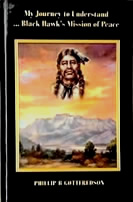
The first serious outbreak was occasioned by three of our people, namely: Richard A. Ivie, Y. Rufus Stoddard and Gerome Zabriskie, who met an Indian called Old Bishop near the fort, and claimed a shirt the Indian had on. The Indian re-fused to give it up. Ivie claimed it as his and tried to take it, was resisted and in the scuffle that in-sued, the Indian was killed, and his body cavity weighted with rock, was sunk in the river, so reported by the Indians, who found the body after 24 hours search.
The murder of Old Bishop, occurred about the 1st of August, 1849, and immediately caused great excitement amongst the Indians, especially the Timpanogos, located on their own land and in proximity of Fort Utah. The Timpanogos first demanded the murderers be turned over to them which of course, was re-fused by the whites. They then required compensation in cattle and horses, but nothing was ever given, and shortly after this cattle and horses were found with arrows sticking in them, several persons were shot at while in the woods and other places. Meanwhile the people prepared for defense. Peter W. Conover was chosen Captain of Militia with E. T. Thomas and G. T. Willis, lieutenants, Miles Weaver, adjutant, Joseph Clark, sergeant. Guards were posted at night and armed herdsmen on horseback, kept the stock by day. The leading Indians ordered the people off their lands. They made serious threats in case of failure to leave and stock was stolen from time to time. - (Source: Peter Gottfredson Indian Depredations in Utah)
Note: This tragic event was a prelude to the massacre that followed at Fort Utah in February 1850 and the decision made by LDS Church authorities to "exterminate" the Timpanogos Nation. Young Black Hawk was held prisoner by Brigham Young in Salt, falsely accused of stealing Brigham's horses. It would be reasonable to conclude that because Brigham and the Council of the Twelve had given the order to exterminate the Tribe, Church authorities took no action against Richard A. Ivie, Y. Rufus Stoddard, and Gerome Zabriskie. A man's life in exchange for a shirt is hard to justify in any era or circumstance. But, this was only the beginning of two decades of Mormon colonialism, whose aim was to establish the kingdom of God.
Next: Battle Creek Canyon & Fort Utah
